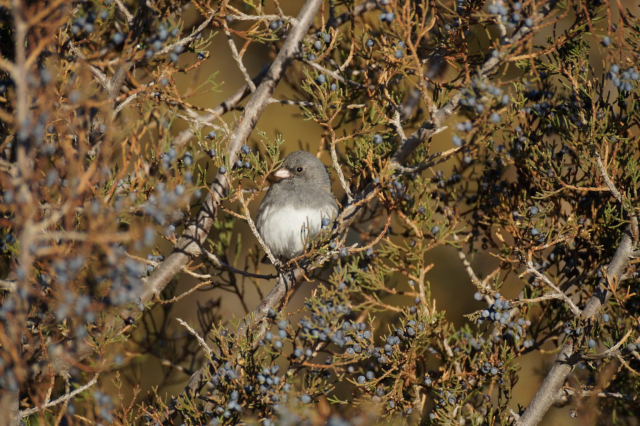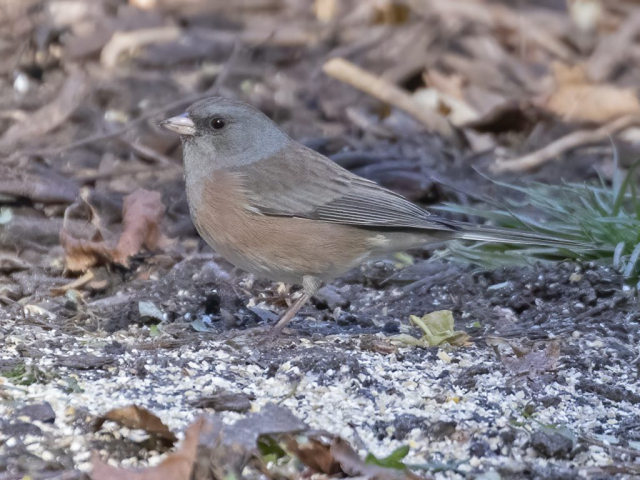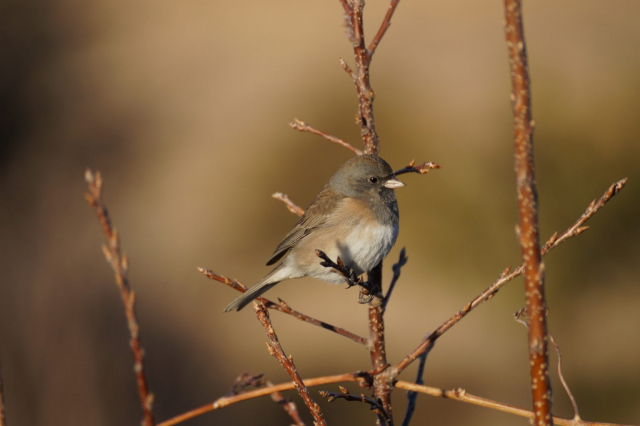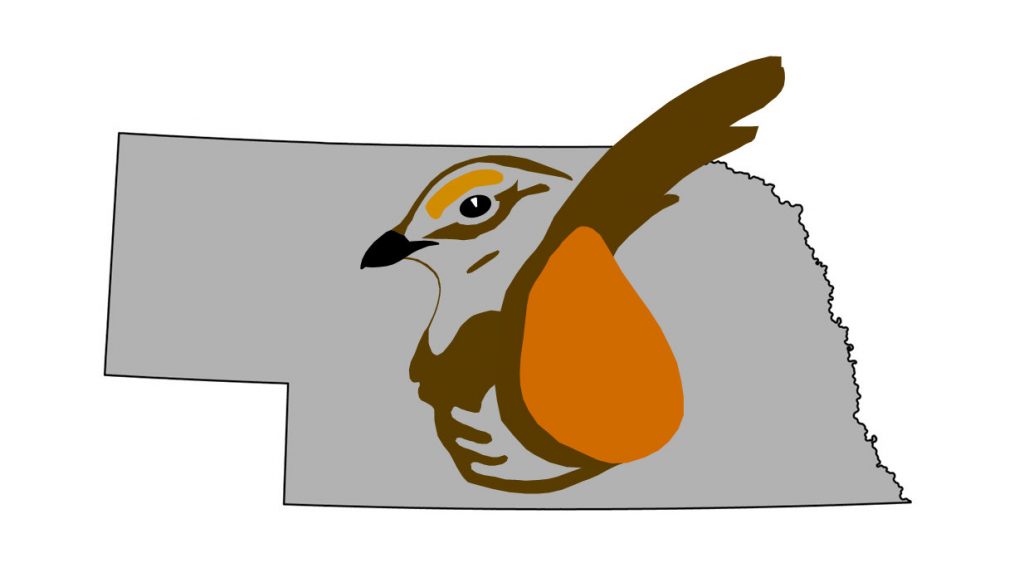Junco hyemalis
Fifteen subspecies are recognized (AviList 2025).
There have been varying treatments of the subspecific taxa within this species over the years; some have been considered full species at times, and as stated by Nolan et al (2020): “The phylogenetic relationships of all junco taxa clearly involve more complex questions than can be answered by presently available evidence”.
Current authors (Pyle 1997, Nolan et al 2020) divide the taxa into several groups but vary as to which taxa are included in each. Herein, we treat 13 subspecies in groups as follows, considering shufeldti and montanus as synonymous (contra AviList), recognizing simillimus (contra AviList, see Oregon Junco below) and merging mutabilis with thurberi (contra AviList): (1) Slate-colored: hyemalis, carolinensis, (2) Cassiar: cismontanus, (3) Oregon: oreganus, shufeldti (=montanus), simillimus, thurberi (including mutabilis), pontilis, pinosus, (4) Pink-sided: mearnsi, townsendi, (5) Gray-headed: caniceps, dorsalis, and (6) White-winged: aikeni.
Former subspecies insularis, Guadalupe Junco of Guadalupe Island, Mexico, was recently split as a full species (AviList 2025).
Mila et al (2007) studied diversification in the genus Junco using mitochondrial DNA; their results supported a hypothesis of expansion from the south involving yellow-eyed juncos, followed by rapid diversification of derived dark-eyed juncos in the north. These results suggest that rapid expansion post-glaciation (Last Glacial Maximum) into previously unoccupied regions that leads to rapid diversification “may provide a speciation mechanism alternative to traditional modes of Pleistocene speciation”.
Hybrids of Dark-eyed Junco and White-throated Sparrow are numerous in the eastern US; nearest to Nebraska are two in Iowa, two in Minnesota, and one in Arkansas (eBird.org, accessed Dec 2023).
Junco subspecies are not uniformly distributed across the state in winter as all but Slate-colored occur in higher proportions in central and western Nebraska based on CBC data (Table 1, see below).
Table 1. Total number and percentages of different junco subspecies (cismontanus not included) recorded on Nebraska Christmas Bird Counts (CBCs) in western, central and eastern Nebraska 2006-2007 through 2014-2015.

Dark-eyed (Slate-colored) Junco
J. h. hyemalis
Status: Abundant regular spring and fall migrant and winter visitor statewide.
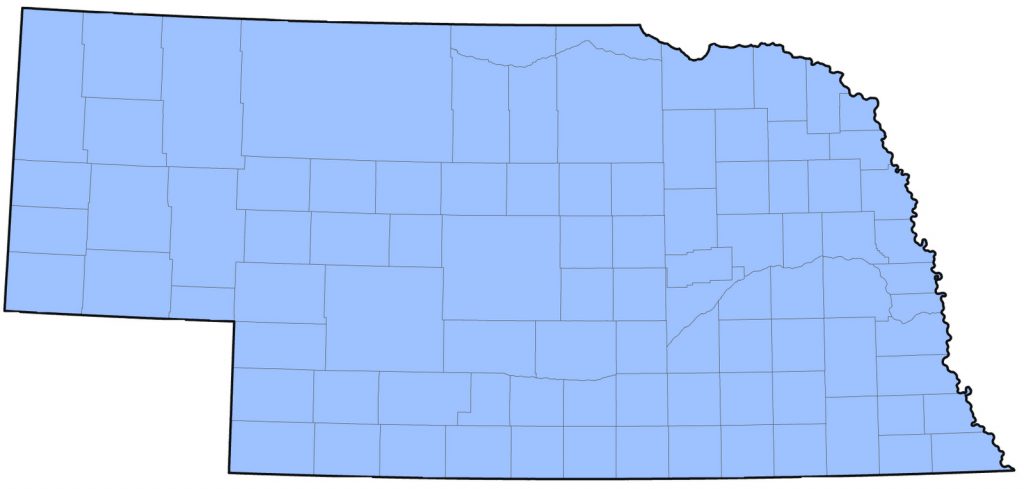
Documentation: Specimen: UNSM ZM7380, 16 Oct 1907 Lancaster Co.
Taxonomy: Two subspecies are recognized, hyemalis breeding from Alaska east to Newfoundland and south to south-central Alaska, northeast British Columbia, and from central Alberta east to Pennsylvania, New York, and southern New England, wintering mainly south of breeding range and east of the Rocky Mountains south to northern Mexico and northern Florida, and carolinensis of the Appalachian Mountains.
Nebraska birds are hyemalis.
Included here are those juncos unspecified as to form and away from the Pine Ridge; “Slate-colored” Junco is by far the most numerous form statewide.
Spring: winter <<<>>> May 14, 14, 15
Later dates away from the Pine Ridge of stated or presumed “Slate-colored” Juncos are 19 May 2013 Washington Co, 19 May 2014 Nemaha Co, 17-21 May 2025 Douglas Co, and 23 May 2013 Keya Paha Co.
Most depart by late Apr, although peak migration is in late Mar-early Apr; it was “abundant” in Saunders Co 12 Mar-18 Apr 1994.
One that was inside a Walmart store in Omaha, Douglas Co through winter and spring 2003-2004 was still present 22 Jun 2004, feeding on spilled bird seed. A female at the Gavin’s Point Dam Visitor Center, Cedar Co for “a few weeks” through 30 Jul 2014 may have actually been an immature male that molted in late Jul; an “adult male” was reported there 30 Jul-1 Aug 2014.
- High counts: 350 at Branched Oak Lake, Lancaster Co 1 Apr 2018, 300 at Crane Trust, Hall Co 16 Apr 2018, 243 at Branched Oak Lake 27 Mar 2020, and 241 at Fort Kearny SRA, Buffalo Co 29 Mar 2022.
Fall: Sep 15, 15, 16 <<<>>> winter
Earlier dates are 31 Aug 2009 banded Wildcat Hills NC, Scotts Bluff Co, 6 Sep 1971 Sarpy Co, 6 Sep 2012 Wildcat Hills NC, 9 Sep 2024 Sioux Co, 10 Sep 2023 Oliver Reservoir, Kimball Co, and 11 Sep 2010 Wind Springs Ranch, Sioux Co.
Migrants arrive in the west and north in mid-Sep and are statewide by late Sep; peak movement is in Oct (Johnsgard 1997).
- High counts: 250 at Forest Lawn Cemetery, Omaha 28 Oct 2010, 250 at Gering Cemetery, Scotts Bluff Co 23 Nov 2024, and 210 in Lancaster Co 14 Nov 1997. “Hundreds” were in Lincoln Co 2 Nov 2004 and 7 Nov 2007.
Winter: Numbers of wintering juncos vary considerably from year to year as pointed out by Rosche (1982) for the northwest, and as shown by CBC data. For CBCs 1984-1985 through 2015-2016, birds per party-hour have been fairly consistently in the 2-7 range, perhaps rising slightly, with peaks 1983-1984, 1990-1991, 1999-2000, and 2007-2008. High CBC totals were 11,489 in 2007-2008 and 7283 in 1994-1995.
In winter 2023-2024 numbers were very high statewide; a careful estimate showed a total of 17,740, as compared to highest CBC total of 11,489.
-
- High counts: “thousands” in Howard Co 8 Jan 1995, 450 at Norfolk, Madison Co 21 Dec 2019, and 232 at Swanson Reservoir, Hitchcock Co 15 Dec 2018.
Dark-eyed (Cassiar) Junco
J. h. cismontanus
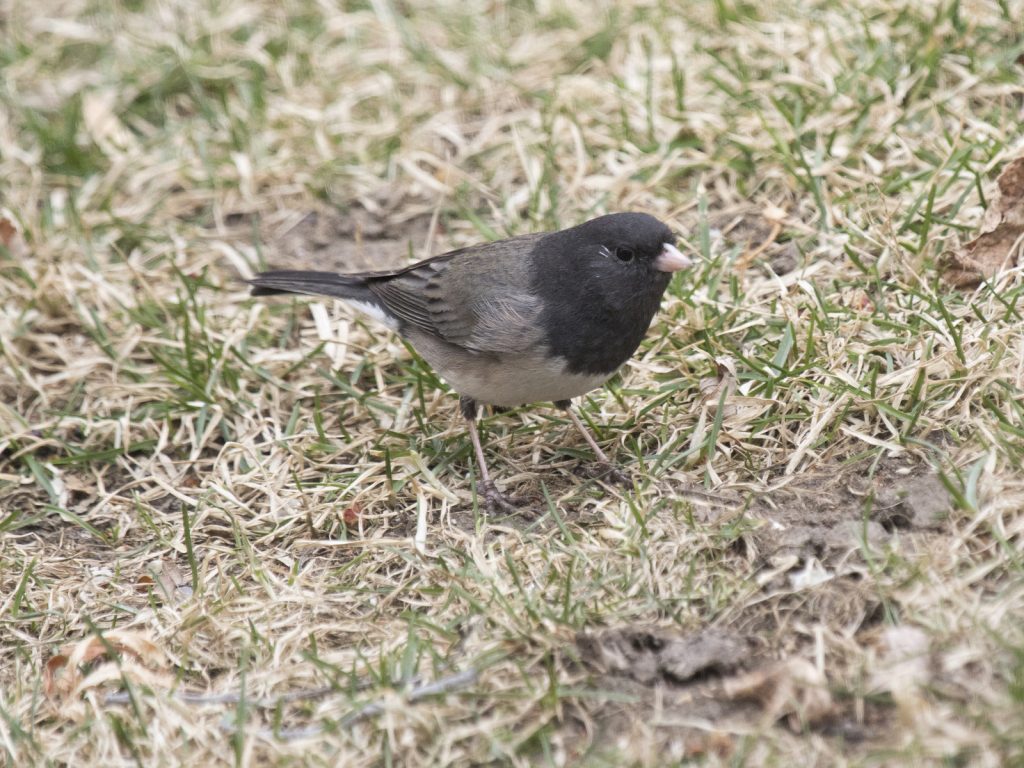
Cassiar Junco at Papillion, Sarpy Co 12 Mar 2007. Photo by Phil Swanson.
Status: Uncommon regular spring and fall migrant and winter visitor statewide.

Documentation: Specimen: UNSM ZM7401, 30 Mar 1915 Long Pine, Brown Co.
Taxonomy: One subspecies is recognized; cismontanus breeds from Yukon to central British Columbia and west-central Alberta, wintering from California to Texas.
Subspecies cismontanus may be a “stable population of apparent hybrids between Slate-colored and Oregon [presumably mearnsi] Juncos” (Rising 1995, Wright 2013), although it is generally identifiable in the field, especially males, which resemble “Slate-colored” Juncos with blackish hoods and on occasion very limited pinkish anterior flanks. Females are similar to some female “Oregon” Juncos, but usually show at least some grayish flank wash, unlike the latter, but “are often completely indistinguishable from either Oregon or Slate-colored Juncos, or, most signally, from hybrids and intergrades that blur the features of both” (Wright 2019). Furthermore, Wright (2019), in noting that “Classic black-hooded, gray-flanked, Cassiar-like males … have been photographed as far east as Nova Scotia and New Jersey”, pointed out that “even in those cases, there can be no certainty that the birds are not hybrids [presumably used in the strict, F1 hybrid sense] rather than genuine cismontanus…”.
eBird (eBird.org) offers a reporting option “Slate-colored/cismontanus“, presumably for birds not clearly cismontanus; there are several such reports in eBird.
An apparent female cismontanus in a Sarpy Co yard 17 Mar 2021 had a prominent white feathered eye ring and was likely the same bird there 24 Oct 2020 (Phil Swanson, personal communication; photos).
Wright (2013) discussed the presence of eight specimens at UNSM of this taxon; three of these were the Long Pine specimen cited above and two collected at Lincoln, Lancaster Co (Moser 1946, AOU 1957).
Spring: winter <<<>>> Apr 21, 22, 23
This subspecies usually occurs with Slate-colored Juncos, and so its temporal distribution may be similar. There are few data, but as observers become more familiar with it, observations are expected to increase.
Fall: Oct 8, 9, 9 <<<>> winter
Earlier dates are 26 Sep 2023 Douglas Co, 26 Sep 2024 Ogallala, Keith Co, 29 Sep 2022 Kimball Co, and 3 Oct 2022 Dawes Co.
Eight were reported statewide in fall 2020, 28 in fall 2021, and 34 in fall 2024, including 8 at Walnut Creek RA, Sarpy Co 6 Nov. See comments under Spring.
Winter: Most reports are from the west, south, and east; the only reports for Dec-Feb in the north are 28 Dec 2020 Thomas Co, 6 Jan 2024 Thedford, Cherry Co, 26 Jan 2013 Custer Co, 25 Feb 2022 Antelope Co, and 27 Feb 2020 Valentine, Cherry Co.
CBC data are lacking.
High counts 2020-2021 were 42 near Gering, Scotts Bluff Co 13 Feb and 30 near Doniphan, Hall Co 19 Dec.
Dark-eyed (Oregon) Junco
J. H. SHUFELDTI (= MONTANUS)
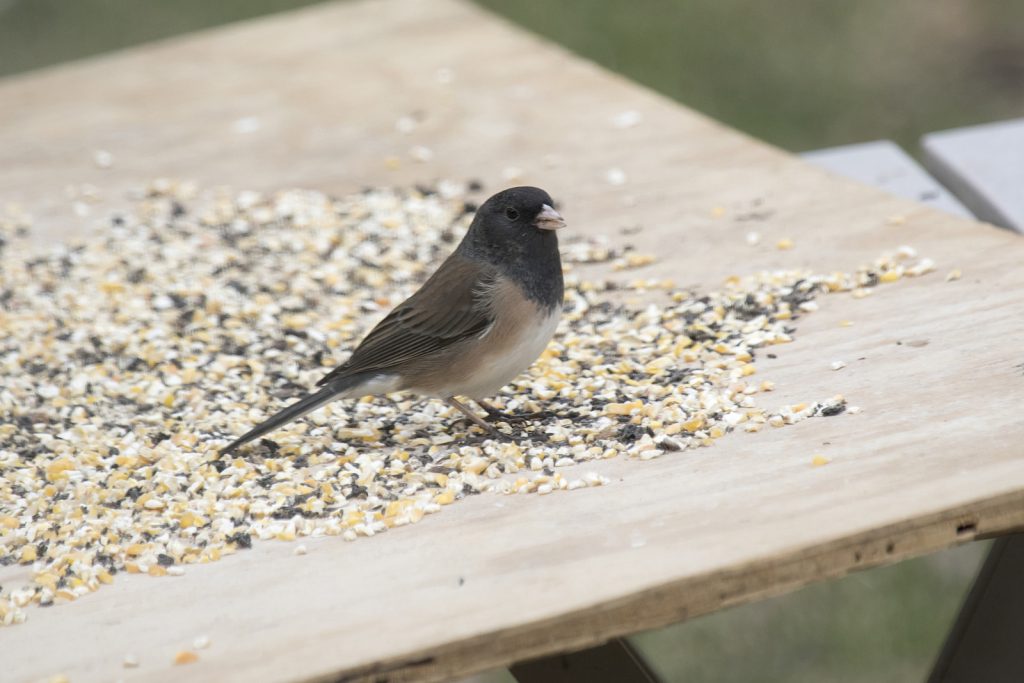
Status: Abundant regular spring and fall migrant and winter visitor west, common central, uncommon east.
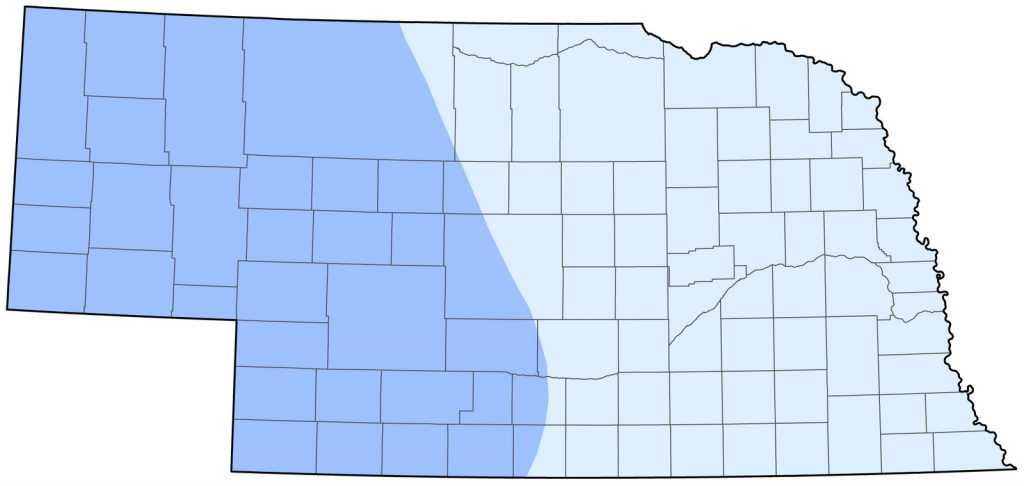
Documentation: Specimen: shufeldti, UNSM ZM10381, 8 Dec 1910 Dawes Co.
Taxonomy: Six subspecies are recognized as comprising the “Oregon Junco” group: oreganus, simillimus, shufeldti (= montanus), thurberi (including mutabilis), pontilis, and pinosus. Of these, shufeldti (montanus) is the only one likely to occur in Nebraska based on ranges (Nolan et al 2020, Avilist 2025); shufeldti (montanus) breeds from central interior British Columbia and southwest Alberta south through northwest Montana, western Idaho (north of Snake River), eastern Washington, and eastern Oregon, wintering chiefly to lower mountains of Colorado, New Mexico, and Arizona, as well as west to California, south to central Chihuahua, and east to eastern Kansas.
There has been much confusion over the taxonomy in this group as it relates to montanus and shufeldti. Subspecies shufeldti was renamed J. h. simillimus by Phillips (1961) who proposed that the type of J. h. shufeldti was a J. h. montanus (Nolan et al 2020). Browning (1990) retained simillimus as did Pyle (1997), who, as a logical result, synonymized montanus and shufeldti, the latter having precedence. The breeding range of simillimus includes coastal coniferous forests from southwest British Columbia south through western Washington and western Oregon, wintering in breeding range south to California and sparsely to southeast Idaho, Colorado, west Texas, and Chihuahua. Thus, it seems unlikely simillimus would occur in Nebraska.
Although Avilist (2025) does not recognize simillimus and retains separate montanus and shufeldti, we follow Phillips (1961) in recognizing simillimus and Pyle (1997) in synonymizing shufeldti and montanus.
The discussion regarding shufeldti and montanus is pertinent to Nebraska. There are two specimens at UNSM labeled as both shufeldti and montanus (ZM10375, 8 Dec 1910 Dawes Co, and ZM10377, 3 Dec 1910 Dawes Co), indicating the confusing taxonomic environment that existed for many years. Bruner et al (1904) were perplexed also, noting that records of “Oregon Junco” for Nebraska “should probably be placed“ under J. h. shufeldti or J. montanus, but “Just which one is referred to in each case is now impossible to definitely state owing to the extreme similarity of the two species, but it is certain that both are represented”. It is unclear whether any of the Nebraska specimens can be assigned to simillimus.
“Oregon” Juncos reported in Nebraska are presumed shufeldti (montanus), the most likely form based on currently recognized ranges (see above).
There are nine records of “Oregon” Junco x “Pink-sided” Junco intergrades for Nebraska (eBird.org, accessed Jun 2024): 26 Sep 2022 Dundy Co, 31 Oct 2022 Wildcat Hills NC, Scotts Bluff Co, 16 Nov 2020 Dundy Co, 12 Dec 2020 Wildcat Hills NC, 20 Dec 2023 Sioux Co, 4 Feb 2021 Hall Co, 14 Feb 2024 Scotts Bluff Co, 3 Mar 2021 Wildcat Hills NC (apparently same bird as reported there 12 Dec 2020), and 31 Mar 2024 Omaha, Douglas Co. A junco in Douglas Co 22 Jan-12 Feb 2021 showed characters of intergradation between Pink-sided Junco and Oregon Junco such as blackish markings in a darker gray “bib” and grayish feathering on the flanks.
Spring: winter <<<>>> Apr 22, 22, 22 (Tout 1947)
Later dates are 25 Apr 2022 Scotts Bluff Co, 27 Apr 2013 Dundy Co, 28 Apr 1935 Lincoln Co (Tout 1947), 28 Apr 2012 Douglas Co, 30 Apr 1995 Sioux Co, 1 May 2013 Kimball Co, and 2 May 2013 Perkins Co.
Fall: Sep 9, 10, 10 <<< >>> winter (west and central); Oct 16, 17, 17 <<< >>> winter (east)
Earlier dates in the west and central are 5 Sep 2015 East Ash Canyon, Dawes Co, and 7 Sep 2019 Chadron SP, Dawes Co.
Earlier dates in the east are 24 Sep 2015 Lancaster Co, 8 Oct 2020 Merrick Co, 9 Oct 2015 Lancaster Co, and 11 Oct 2003 Douglas Co.
The limited available data indicate that “Oregon” Junco arrives later in fall and leaves earlier in spring than “Slate-colored” Junco, especially in the east.
-
-
- High counts: 85 at Lake Ogallala, Keith Co 11 Nov 2024, 70 at Rock Creek SRA, Dundy Co 16 Nov 2020, and 55 from Minatare to Lake Alice, Scotts Bluff Co 14 Nov 2024.
-
Winter: Rosche (1982) stated that “Pink-sided” Juncos are the most common form in the northwest in winter, followed by “Oregon” Juncos and “Slate-colored” Juncos. A similar mix was reported by Rosche (1994) in the Keith Co area, although Tout (1947) stated that “Pink-sided” Juncos were “not common” in Lincoln Co, and Brown and Brown (2001) noted that most in the Keith Co area were “Oregon” Juncos.
“Oregon” Juncos are far more common in the Panhandle than easterly, as indicated in the table above. Banding studies indicated that “Oregon” Juncos comprised about 10% of juncos in the east, increasing to 50% at Alda, Hall Co (Thomas Labedz, personal communication).
Good westerly counts are 100 at Lake Ogallala, Keith Co 23 Dec 2024, 90 at Buffalo Creek WMA, Scotts Bluff Co 20 Dec 2024, and 59 at Lake McConaughy, Keith Co 1 Dec 2022, and in the east 20 at each of two locations in Cass Co 17 Feb 2019, and eight on the DeSoto CBC 15 Dec 2019.
Dark-eyed (Pink-sided) Junco
J. h. mearnsi

Status: Common regular spring and fall migrant and winter visitor west, uncommon central, rare casual east.
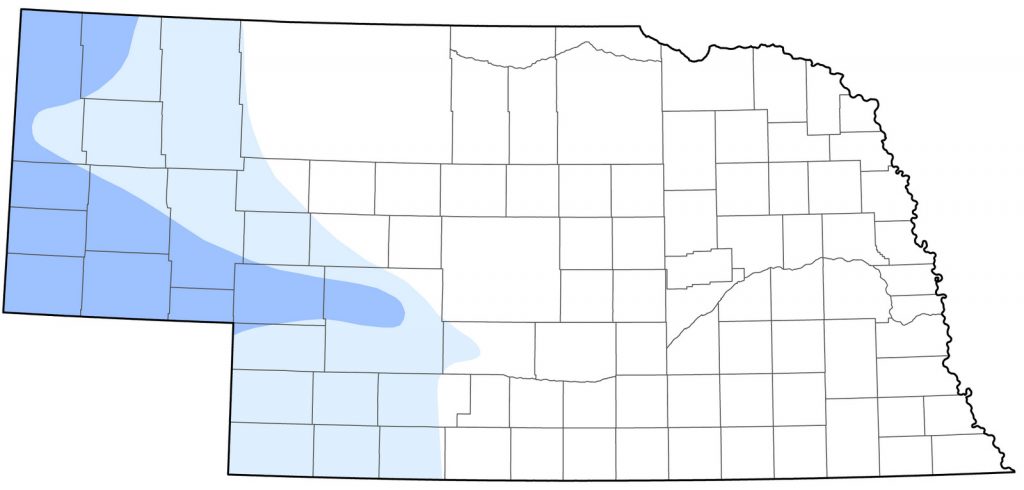
Documentation: Specimen: UNSM ZM7387, 19 Sep 1919 Sioux Co (Mickel and Dawson 1920).
Taxonomy: Two subspecies are recognized, mearnsi breeding from southeast Alberta and southwest Saskatchewan south through eastern Idaho, central Montana, and northeast Wyoming, wintering from northern Utah, northwestern Wyoming, and central Nebraska south to Mexico and west Texas, and townsendi of northern Baja California.
Nebraska birds are mearnsi.
See Oregon Junco (above) for intergrades with that form, and White-winged Junco (below) for intergrades with that form.
There are numerous records of Pink-sided Junco x Gray-headed Junco in Colorado, but none as yet for Nebraska; the closest records of this intergrade are in Washington Co, Colorado, and Sherman Co, Kansas (eBird.org, accessed Jun 2024).
Spring: winter <<<>>> Apr 30, May 1, 3
An earlier date is 25 Apr 2022 Scotts Bluff Co.
Fall: Sep 19, 19, 19 <<< >>> winter
Earlier dates are 3 Sep 2017 Sioux Co, 4 Sep 2017 Banner Co, 7 Sep 2000 one netted at Oliver Reservoir, Kimball Co (Dinsmore 2000), 7 Sep 2015 Kimball Co, 8 Sep 2015 one netted at Chadron SP, Dawes Co, 9 Sep 2024 Sioux Co, 11 Sep 2021 Crescent Lake NWR, Garden Co, 15 Sep 2015 Dawes Co, and 15 Sep 2023 Oliver Reservoir.
Tout (1947) stated that “Pink-sided” Juncos were “not common” in Lincoln Co, occurring in the period 10 Oct-22 Apr.
-
-
- High counts: 27 in Carter Canyon, Scotts Bluff Co 29 Nov 2019, 25 in Sowbelly Canyon, Sioux Co 19 Oct 2019, and 25 along Old Stage Road, Scotts Bluff Co 26 Oct 2020.
-
Winter: The highest numbers occur in the west (Rosche 1982) but decline rapidly eastward. See CBC data in table above.
Reports from the east were not well-documented until recently; there had been about 28 reports in the period 23 Oct-11 Apr although we believe that many are likely to be intergrades or female “Cassiar” or “Oregon” Juncos.
Reports for the east on eBird.org accompanied by photographs are 23 Oct 2020-12 Feb 2021 Sarpy Co, 27 Oct Lancaster Co, 28 Nov 2020 Lancaster Co, 2-24 Jan 2021 Wayne Co, 3 Jan 2024 Douglas Co, 7 Jan-20 Mar 2017 Knox Co, 10 Jan 2021 Lancaster Co, and 22 Jan 2021 Douglas Co, 7 Feb 2024 Sarpy Co, 6 Mar 2024 Sarpy Co, 9 Mar Nance Co, 22 Mar 2022 Seward Co, and 11 Apr 2022 Sarpy Co.
Additional accepted easterly reports well-described by an experienced observer or photographed are: one in Lancaster Co 3 Dec 2018, one in Dixon Co 14 Dec 2022, one at Branched Oak Lake, Lancaster Co 21 Dec 2024, one at Lincoln, Lancaster Co 21 Jan 2019, and one photographed at Lincoln, Lancaster Co 22-27 Feb 2011.
- High counts: 21 at Wright’s Gap Road, Banner Co 5 Feb 2024, and 15 at Buffalo Creek WMA, Scotts Bluff Co 20 Dec 2024.
Dark-eyed (Gray-headed) Junco
J. h. caniceps
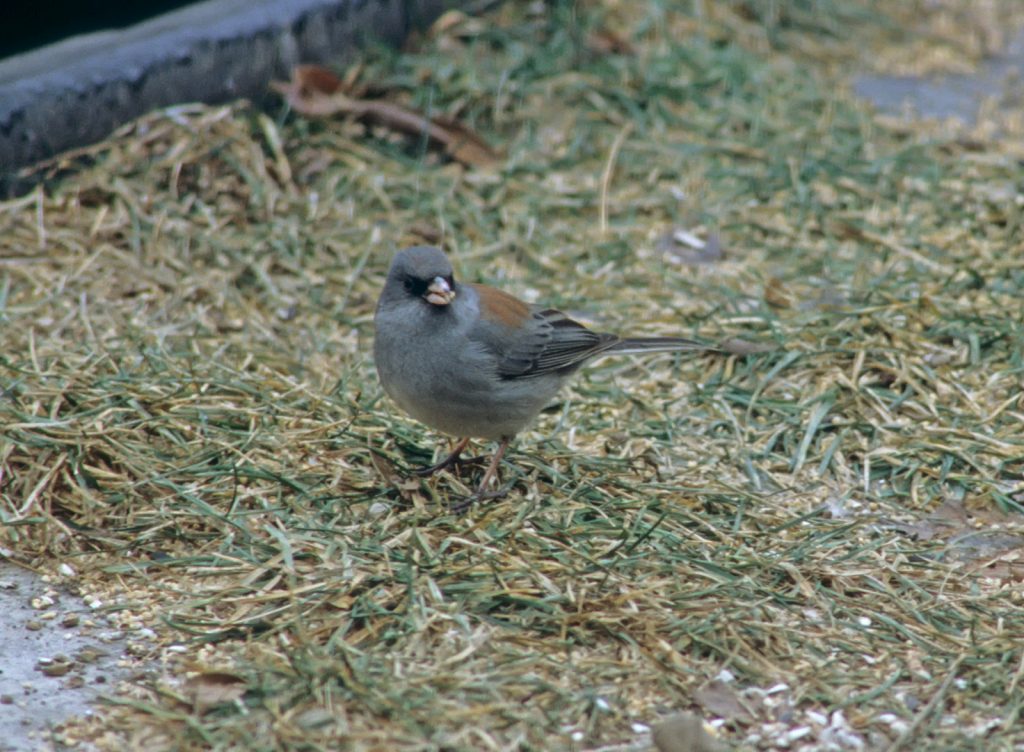
Status: Rare casual winter visitor statewide.
Documentation: Specimen: UNSM ZM10385, 19 Apr 1911 Red Cloud, Webster Co.
Taxonomy: Two subspecies are recognized, caniceps, breeding in mountains from southern Idaho eastward to the Laramie Mountains in Wyoming, southward to southeastern California, eastern Nevada, northern Arizona, and New Mexico, wintering from Utah and Colorado southward to northern Mexico and eastward to southwestern Texas, and dorsalis, breeding in mountains of New Mexico, northern Arizona, and far western Texas.
The closeness of breeding caniceps in the Laramie Mountains of Wyoming (Faulkner 2010) and the southwestern distribution of dorsalis suggests Nebraska birds are caniceps. Maps in eBird (accessed Dec 2023) suggest that in winter there is limited movement from the central Rocky Mountains onto the Great Plains.
There have been many reports of “Gray-headed” Junco in Nebraska, most undocumented, and it is likely that many are in fact examples of hybrids between various forms of “Oregon Junco” or brightly marked examples of mearnsi. Sutton (1975) collected several birds resembling this form in Oklahoma, but none were found to be true “Gray-headed Juncos”.
A photograph of a junco in Omaha, Douglas Co Mar 2006 shows what appears to be a hybrid between “Gray-headed” and “Oregon” (likely mearnsi Pink-sided) Juncos, often referred to as “Ridgway’s Junco” (Wright 2019, Rick Wright, personal communication), a rare occurrence in itself, especially in eastern Nebraska.
Winter: There are only 25 accepted records, despite about 60 reports and the statement by Tout (1947) that caniceps was an “irregular winter resident in Lincoln Co, rather common in some years, rare during others.” In the 10 years 2016-2025 there have been five records.
The 24 accepted records are in the period 30 Aug-5 Jun, most in the west, but these three for the east: one in a Papillion, Sarpy Co yard 16 Jan-9 Mar 2000 was photographed, one in a Bellevue, Sarpy Co yard unaccompanied by other juncos 2 Oct 1977 was said to be “like the slightly larger juncos of Colorado with the large rufous patch on the back” (Cortelyou 1978), and one hit a window in Lincoln, Lancaster Co 27 Apr 1982, was rehabilitated, banded, and released 18 May (Cortelyou 1982); a report from Lancaster Co 13 Apr 1982 (Williams 1982a) probably referred to the same bird.
There are six records in the central: one was banded at NNF Bessey, Thomas Co 27 Sep 2003, one was photographed in Lincoln Co 13 Apr 2025, and another in Lincoln Co 16 Apr 2015, one at Red Cloud, Webster Co 11-19 Apr 1911 (Bates 1924) was taken on the latter date and is the specimen cited above, one was described near Sutherland, Lincoln Co 6 May 2020, and singles were in Grant Co 4 Jun 1986 (Mollhoff 1987) and 10 Apr 2013 (photo, Glenda Burgess).
The remaining 16 records are from the west: 31 Aug-1 Sep 2012 Mitchell, Scotts Bluff Co, 12 Sep 1998 Scotts Bluff NM, Scotts Bluff Co, 18 Dec 2010 Scottsbluff CBC, 20 Dec 2014 Scotts Bluff CBC, 27 Dec 1977 Crawford CBC, 2 Feb 2001 photographed at Riverside Park Zoo, Scottsbluff (Jorgensen 2003), 5 Feb 2024 Banner Co, 13 Mar 2023 (2) Morrill Co, one flew into a garage door near Gering, Scotts Bluff Co 12 Apr 2010 and stayed through 15 Apr, 7 May 2009 Wind Springs Ranch, Sioux Co, two on 8-9 May 2011 Wind Springs Ranch, 19 May 2018 Monroe Canyon, Sioux Co, 22 May 2010 North Platte, Lincoln Co and 5 Jun 1982 at Crescent Lake NWR, Garden Co (Williams 1982b).
Dark-eyed (White-winged) Junco
J. h. aikeni
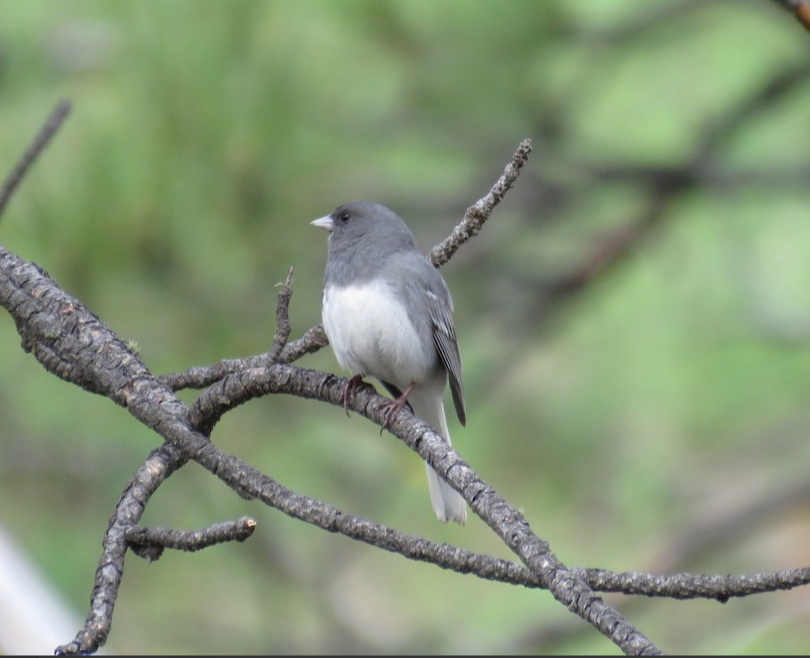
Status: Rare regular resident Pine Ridge. Uncommon regular winter visitor west and west-central, rare casual elsewhere. Rare regular spring and fall migrant west and west-central, rare casual elsewhere.

Documentation: Specimen: UNSM ZM7366, 12 Dec 1895 Fort Robinson, Dawes Co.
Taxonomy: One subspecies is recognized, aikeni, breeding in a fairly restricted region, including the Rosebud and Long Pine Hills of southeastern Montana, the Black Hills and Short Pine Hills of southwestern South Dakota, the Bear Lodge Mountains and Black Hills of northeastern Wyoming, and northern Sioux Co of northwestern Nebraska, wintering throughout the breeding area east to central South Dakota and south through southwestern Colorado, north-central New Mexico, western Oklahoma, and western Kansas (Nolan et al 2020).
Bruner (1896) mentioned the collection of a specimen of aikeni with “decidedly pinkish sides,” presumably in Sioux Co. In winter 2020-2021 similar birds were photographed in Scotts Bluff Co 20 and 22 Nov (Mlodinow, eBird.org) and in Morrill Co 10 and 17 Jan (Strand, Winter; eBird.org), Subsequently, there have been five additional records, all by Steven Mlodinow: 20 Sep 2022 Kimball Co, 18 Oct 2022 Scotts Bluff Co, 23 Oct 2023 Scotts Bluff Co, 10 Nov 2023 Scotts Bluff Co, and 29 Nov 2021 Scotts Bluff Co. These birds appear to have been intergrades with mearnsi, which breeds in the Bighorn Mountains of northern Wyoming and whose range approaches within about 20 miles of that of aikeni in western Powder River County, Montana, at a location where extensive interbreeding occurred at one time (Miller 1941). More recently, however, no hybrids could be located in the area, and the current breeding range of aikeni appears to be separated from that of any other junco form (Nolan et al 2020).
Mila et al (2007) found that differentiation of the white-winged junco population “could be due to founder events and the subsequent fixation of rare alleles in a population of small effective size, although the influence of natural selection cannot be ruled out. The fact that some pink-sided juncos from the nearby Bighorn Mountains of Wyoming and even some Oregon juncos cluster with the white-winged juncos suggests that the alleles involved appeared (or became fixed) in the small Black Hills population and spread west through gene flow across hybrid zones”.
Resident: “White-winged Juncos” are rare in summer on the Pine Ridge, occurring mostly in the westerly canyons such as Monroe (Rosche 1982) and Warbonnet (Bruner et al 1904). There are only about 11 records for the Pine Ridge May-Aug (eBird.org, accessed 18 Aug 2024; surveys 4-19 Jun 2025 added several reports. Numbers increase slowly beginning mid-Apr (see Winter last dates) and apparently remain relatively constant until Jan. An apparent incursion on the Pine Ridge in Jan 2021 suggested that a strong southward movement, likely augmented by Black Hills birds, may occur on occasion in Jan and decline rapidly thereafter, since there is only one Pine Ridge record for Feb-Mar, that in the same 2021 incursion year, 6 Feb 2021. The high Jan counts in 2021 were 93 at Chadron Creek WMA, Dawes Co 29 Jan 2021, 85 in Monroe Canyon 3 Jan 2021, and 65 in Sowbelly Canyon, Sioux Co 6-17 2021.
The eastern limit of the breeding range has moved east in recent years; Mollhoff (2001, 2016) showed that between the two atlas periods (1984-1989 and 2006-2011) the range expanded eastward from central Dawes Co to northeastern Sheridan Co. Mollhoff (2022) found a nest with nestlings at Chadron Creek Ranch WMA, Dawes Co 12 Jun 2008, noting that extreme wariness on the part of nesting adults make the nests difficult to locate.
Very strange was the virtual lack of reports for the Pine Ridge for Jun-Sep 2022; the only report was in Jun-Jul, and none were found on some 15 point counts in Jun 2022 along the Pine Ridge from Sioux Co to Dawes Co (Stephen Brenner, personal communication). Similarly, in 2024 none were reported Jun-Jul. Surveys done 4-19 Jun 2025 tallied about 10 juncos (eBird.org), but these may have been Black Hills migrants rather than Pine Ridge breeders, although on one of these locations, west of Carter Johnson Reservoir, Sioux Co, an adult was carrying food 4 Jun 2025.
During Aug-Sep summering birds should still be present and migrants from the Black Hills, South Dakota should be in evidence.
Ducey (1988) listed a report of breeding in Holt Co in 1901, but no details were provided.
-
-
- Breeding phenology:
Nestlings: 4 Jun- 29 Jun (Mollhoff 2022)
Fledglings: 8 Jun- 11 Jul
- Breeding phenology:
-
Spring: Movements from the breeding range occur most winters but are irregular and it is difficult to assign dates for birds returning to the breeding range. However, birds wintering in Colorado depart by mid-Apr (Andrews and Righter 1992) and Nebraska last winter dates away from the breeding range are in early Apr. Migrants in Nebraska, including Pine Ridge sightings in Apr, may be South Dakota Black Hills breeders; numbers on the Pine Ridge May-Jul are often low.
Easterly reports are 5 Mar 2019 Hall Co, 18 Mar 2013 Lincoln Co, 21 Mar 2023 Lincoln Co, and 20-24 Mar 1940 Lincoln Co (Tout 1947).
A remarkable record of 40 White-winged Juncos in a flock in Lincoln Co 6 Jun 1911 was cited by Wright (2019); Wilson Tout observed this flock, which had been in the area for several weeks, finally capturing one (Tout 1947).
Fall: Detectable numbers drift southward beginning in Sep. There does not appear to be a concerted southward movement akin to true migration. “White-winged” Juncos wintering south of the breeding range into Colorado arrive around mid-Oct (Andrews and Righter 1992) and early Nebraska dates away from the breeding range are in early Oct.
Easterly reports are rare; there is a specimen in the US National Museum collected in Harlan Co 20 Oct 1856 (USNM A 5707), one was in Perkins Co 30 Oct 2004, and one was in Lancaster Co 1 Nov 2024.
-
-
- High counts: 19 in Carter Canyon, Scotts Bluff Co 20 Nov 2020, and 10 there 10 Nov 2023.
-
Winter: Sep 30, Oct 1, 2 <<<>>> Mar 26, Apr 5, 5 (away from Pine Ridge)
Earlier dates are 6 Sep 2018 Banner Co, 12 Sep 2015 Scotts Bluff Co, and 21-26 Sep 2012 Scotts Bluff Co.
Later dates are 23 Apr 2023 Garden Co, and 4 May 2019 Scotts Bluff Co.
Many summering birds are resident (AOU 1957), although in some winters there is considerable movement south of the summer range, most notably to Colorado (AOU 1957), where it occurs mid-Oct through mid-Apr (Andrews and Righter 1992). The eastern limit of regular wintering in Nebraska appears to be Keith Co (Rosche 1994, Brown et al 1996) although there are reports Nov-early Apr from west central counties Keith, Lincoln, and Logan, with easternmost reports 23 Dec 2002 Harlan County Reservoir, Harlan Co, 12 Feb 1917 a specimen #2782A in the Brooking Collection taken at Inland, Clay Co (Brooking, Notes), 22 Feb 1935 Adams Co, 5 Mar 2019 Hall Co, and 4 Apr 1955 Keya Paha Co.
Some, if not most, easterly reports may in fact be variants of “Slate-colored Junco” with exaggerated wingbars (Robbins 2018); aikeni, however, is a larger and paler bird overall than hyemalis.
-
-
- High counts: 93 at Chadron Creek Ranch WMA 29 Jan 2021, 85 in Monroe Canyon, Sioux Co 3 Jan 2021, and 65 at Sowbelly Canyon, Sioux Co 6 Jan 2021.
-
Images
Abbreviations
AOU: American Ornithologists’ Union
CBC: Christmas Bird Count
NC: Nature Center
NNF: Nebraska National Forest
NM: National Monument
NWR: National Wildlife Refuge
SP: State Park
SRA: State Recreation Area
UNSM: University of Nebraska State Museum
USNM: United States National Museum
WMA: Wildlife Management Area (State)
Literature Cited
Andrews, R., and R. Righter. 1992. Colorado birds. Denver Museum of Natural History, Denver, Colorado, USA.
American Ornithologists’ Union [AOU]. 1957. The AOU Check-list of North American birds, 5th ed. Port City Press, Baltimore, Maryland, USA.
AviList. 2025. The Global Avian Checklist, v2025. https://doi.org/10.2173/avilist.v2025
Bates, J.M. 1924. Handwritten draft (unpublished?) entitled “Twenty-one years of bird study at Red Cloud, Neb.”. NOU Archives.
Brooking, A.M. Notes. Bird specimen records. Manuscript in NOU Archives, University of Nebraska State Museum, Lincoln, Nebraska, USA.
Brown, C.R., M.B. Brown, P.A. Johnsgard, J. Kren, and W.C. Scharf. 1996. Birds of the Cedar Point Biological Station area, Keith and Garden Counties, Nebraska: Seasonal occurrence and breeding data. Transactions of the Nebraska Academy of Sciences 23: 91-108.
Brown, C.R., and M.B. Brown. 2001. Birds of the Cedar Point Biological Station. Occasional Papers of the Cedar Point Biological Station, No. 1.
Browning, M.R. 1990. Taxa of North American birds described from 1957 to 1987. Proceedings Biological Society Washington 103: 432-451.
Bruner, L. 1896. A list of Nebraska birds, together with notes on their abundance, migrations, breeding, food-habits, etc. Nebraska State Horticultural Society 27th Annual Report pp 57-163.
Bruner, L., R.H. Wolcott, and M.H. Swenk. 1904. A preliminary review of the birds of Nebraska, with synopses. Klopp and Bartlett, Omaha, Nebraska, USA.
Clements, J. F., T. S. Schulenberg, M. J. Iliff, D. Roberson, T. A. Fredericks, B. L. Sullivan, and C. L. Wood. 2016. The eBird/Clements checklist of birds of the world: v2016, accessed 30 January 2018.
Cortelyou, R.G. 1978. 1977 (Twentieth) Fall Occurrence Report. NBR 46: 23-35.
Cortelyou, R.G. 1982. 1982 (Fifty-seventh) Spring Occurrence Report. NBR 50: 51-67.
Dinsmore, S.J. 2000. Mist netting at Oliver State Recreation Area. NBR 68: 177-179.
Ducey, J.E. 1988. Nebraska birds, breeding status and distribution. Simmons-Boardman Books, Omaha, Nebraska, USA.
Faulkner, D.W. 2010. Birds of Wyoming. Roberts and Company, Greenwood Village, Colorado, USA.
Johnsgard, P.A. 1997. The birds of Nebraska and adjacent plains states. Occasional Papers No. 6, Nebraska Ornithologists’ Union. Lincoln, Nebraska, USA.
Jorgensen, J.G. 2003. 2001 (13th) Report of the NOU Records Committee. NBR 71: 97-102.
Mickel, C.E., and R.W. Dawson. 1920. Some interesting records of Nebraska birds for the year 1919. Wilson Bulletin 32: 73-79.
Mila, B., J.E McCormack, G. Castañeda, R.K Wayne, and T.B Smith. 2007. Recent postglacial range expansion drives the rapid diversification of a songbird lineage in the genus Junco. Proceedings Biological Science 274: 2653–2660.
Miller, A.H. 1941. Speciation in the avian genus Junco. University of California Publications in Zoology 44: 173-434.
Mollhoff, W.J. 1987. First report of the NOU Records Committee. NBR 55: 79-85.
Mollhoff, W.J. 2001. The Nebraska Breeding Bird Atlas 1984-1989. Nebraska Ornithologists’ Union Occasional Papers No. 7. Nebraska Game and Parks Commission, Lincoln, Nebraska, USA.
Mollhoff, W.J. 2016. The Second Nebraska Breeding Bird Atlas. Bull. Univ. Nebraska State Museum Vol 29. University of Nebraska State Museum, Lincoln, Nebraska, USA.
Mollhoff, W.J. 2022. Nest records of Nebraska birds. Nebraska Ornithologists’ Union Occasional Paper Number 9.
Moser, R.A. 1946. The genus Junco in Nebraska. NBR 14: 1-6.
Nolan Jr., V., E.D. Ketterson, D.A. Cristol, C.M. Rogers, E.D. Clotfelter, R.C. Titus, S.J. Schoech, and E. Snajdr. 2020. Dark-eyed Junco (Junco hyemalis), version 1.0. In Birds of the World (A. F. Poole and F. B. Gill, Editors). Cornell Lab of Ornithology, Ithaca, NY, USA. https://doi.org/10.2173/bow.daejun.01.
Phillips, A. 1961. Notas sistematicas sobre aves Mexicanas. I. Annal. Inst. Biol. Mex. no. 32: 333-381.
Pyle, P. 1997. Identification Guide to North American Birds. Part I, Columbidae to Ploceidae. Slate Creek Press, Bolinas, California, USA.
Rising, J.D. 1995. A guide to the identification and natural history of the sparrows of the United States and Canada. Academic Press, San Diego, California, USA.
Robbins, M.B. 2018. The Status and Distribution of Birds in Missouri. University of Kansas Biodiversity Institute, Lawrence, Kansas, USA.
Rosche, R.C. 1982. Birds of northwestern Nebraska and southwestern South Dakota, an annotated checklist. Cottonwood Press, Crawford, Nebraska, USA.
Rosche, R.C. 1994. Birds of the Lake McConaughy area and the North Platte River valley, Nebraska. Published by the author, Chadron, Nebraska, USA.
Sutton, G.M. 1975. A junco is a junco is a junco. NBR 43: 66-67.
Tout, W. 1947. Lincoln County birds. Published by the author, North Platte, Nebraska, USA.
Williams, F. 1982a. Southern Great Plains Region. American Birds 36: 868-871.
Williams, F. 1982b. Southern Great Plains Region. American Birds 36: 992-995.
Wright, R. 2013. The Junco called Cassiar. NBR 81: 87-93.
Wright, R. 2019. Sparrows of North America, Peterson Reference Guide. Houghton Mifflin Harcourt, Boston and New York.
Recommended Citation
Silcock, W.R., and J.G. Jorgensen. 2025. Dark-eyed Junco (Junco hyemalis). In Birds of Nebraska — Online. www.BirdsofNebraska.org
Birds of Nebraska – Online
Updated 9 Sep 2025
